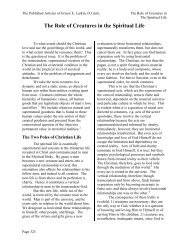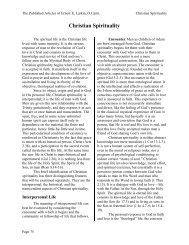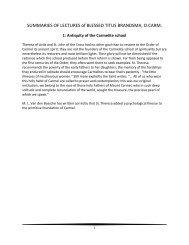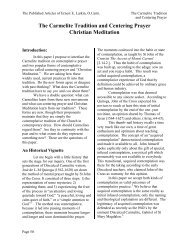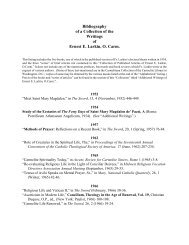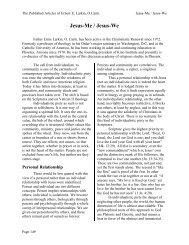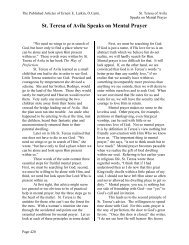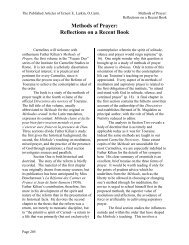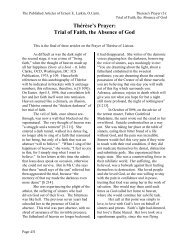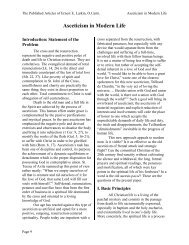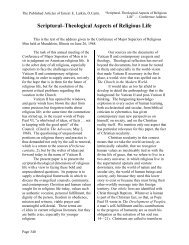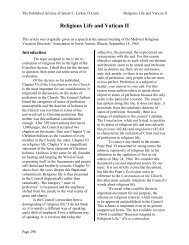John of the Cross=s Message for Today - Carmelnet
John of the Cross=s Message for Today - Carmelnet
John of the Cross=s Message for Today - Carmelnet
You also want an ePaper? Increase the reach of your titles
YUMPU automatically turns print PDFs into web optimized ePapers that Google loves.
The Published Articles <strong>of</strong> Ernest E. Larkin, O.Carm. Spiritual Theologian<br />
The present article is a personal<br />
reminiscence about a man I respected and<br />
loved as teacher, mentor, friend and<br />
colleague in our mutual specialty <strong>of</strong> spiritual<br />
<strong>the</strong>ology. I do not have <strong>the</strong> resources <strong>for</strong> a<br />
detailed, academic evaluation <strong>of</strong> his<br />
contribution to <strong>the</strong> field, but I think this<br />
aspect <strong>of</strong> his work is secondary. His main<br />
contribution was in <strong>the</strong> practical and pastoral<br />
order. His life was his spiritual <strong>the</strong>ology and<br />
provided <strong>the</strong> best model <strong>of</strong> his spiritual<br />
doctrine. He first assimilated <strong>the</strong> riches <strong>of</strong><br />
<strong>the</strong> Christian and Carmelite tradition and<br />
<strong>the</strong>n passed it on in <strong>the</strong> classroom and <strong>the</strong><br />
conference hall as well as in significant<br />
writings. Kilian <strong>the</strong> spiritual <strong>the</strong>ologian is<br />
revealed in his personal life and his<br />
leadership in <strong>the</strong> Order. This Kilian is <strong>the</strong><br />
subject <strong>of</strong> my paper. My sources are<br />
primarily my memories and <strong>the</strong> writings that<br />
are available here in <strong>the</strong> west at some<br />
distance from <strong>the</strong> Carmelitana Collection in<br />
Fr. Kilian=s beloved Washington, D.C.<br />
My first meeting with Fr. Kilian was<br />
in 1940 or 1941 at Mount Carmel College in<br />
Niagara Falls. He was recently back from<br />
Rome, having returned in 1939 when <strong>the</strong><br />
threat <strong>of</strong> war drove him and <strong>the</strong> o<strong>the</strong>r<br />
American students home. On <strong>the</strong> return boat<br />
Kilian was assigned a berth with a young<br />
Holy Cross student named Theodore<br />
Hesburgh, later to become <strong>the</strong> famous<br />
president <strong>of</strong> Notre Dame University.<br />
It was a Sunday afternoon and Kilian<br />
was out <strong>for</strong> a stroll in full habit in <strong>the</strong><br />
playing field behind <strong>the</strong> gym on Stanley<br />
Avenue. A few <strong>of</strong> us fifth year students,<br />
young Carmelites recently pr<strong>of</strong>essed after<br />
<strong>the</strong> novitiate year in New Baltimore, were<br />
throwing a football around. He was <strong>the</strong> new<br />
Page 1<br />
Spiritual Theologian<br />
teacher <strong>of</strong> philosophy <strong>for</strong> <strong>the</strong> sixth and<br />
seventh year students as well as pr<strong>of</strong>essor <strong>of</strong><br />
<strong>the</strong>ology <strong>for</strong> a handful <strong>of</strong> <strong>the</strong> displaced<br />
Roman student priests that included Paul<br />
Kirchner and Edwin McGowan. We engaged<br />
him in conversation.<br />
I remember being a bit stage struck<br />
at <strong>the</strong> meeting. After all, he was like a man<br />
from Mars, a <strong>for</strong>eign pr<strong>of</strong>essor who looked<br />
<strong>the</strong> part. What his background meant we did<br />
not exactly know, so he had an aura <strong>of</strong><br />
strangeness and o<strong>the</strong>rness about him. These<br />
qualities are not far from <strong>the</strong>ir spiritual or<br />
transcendent counterparts. Kilian always<br />
projected a spiritual persona. When we got<br />
to know him better, we found a mix <strong>of</strong><br />
down-to-earth human qualities and o<strong>the</strong>rworldliness.<br />
We found out eventually that<br />
he had been in Rome since 1934, had done<br />
his <strong>the</strong>ology at <strong>the</strong> Collegio Internazionale<br />
di Sant= Alberto, was ordained in 1937, and<br />
stayed on <strong>for</strong> a licentiate and doctoral<br />
studies at <strong>the</strong> Pontifical Gregorian<br />
University. All this history was impressive,<br />
and some <strong>of</strong> it must have seeped through<br />
even in that first meeting. In any case he<br />
definitely was someone special.<br />
Kilian was a spiritual leader all his<br />
life. This set him apart. Our questions at<br />
<strong>the</strong> moment were pedestrian: could he tell<br />
us what it was like to study in Rome? How<br />
was it living in a <strong>for</strong>eign country with<br />
Carmelites from many nations?<br />
He was friendly enough, as I recall,<br />
but not too communicative about life<br />
overseas. Perhaps he suffered a bit <strong>of</strong><br />
shyness, or humility, or he just wanted his<br />
privacy, a Bostonian quality that he inherited<br />
and never lost. In that first meeting he<br />
shared no secrets, so we had to wait <strong>for</strong> his
The Published Articles <strong>of</strong> Ernest E. Larkin, O.Carm. Spiritual Theologian<br />
thoughts about Rome until a later time. Over<br />
<strong>the</strong> years he had much to say about Rome,<br />
and most <strong>of</strong> it was admiration <strong>for</strong> <strong>the</strong> great<br />
men in <strong>the</strong> Order who were his superiors and<br />
teachers, such as <strong>John</strong> Brenninger and<br />
Bartholomew Xiberta.<br />
Sant’ Alberto was an international<br />
Carmelite community in Rome, and in <strong>the</strong><br />
thirties it had <strong>the</strong> reputation <strong>of</strong> being a place<br />
where <strong>the</strong> life was strict, if not rigid. Some<br />
criticized it <strong>for</strong> its tough life style. Not<br />
Kilian. He had only admiration and respect<br />
<strong>for</strong> <strong>the</strong> leadership <strong>of</strong> men like <strong>John</strong><br />
Brenninger and Gabriel Couto, as well as <strong>for</strong><br />
some holy classmates like Blessed Hilarion<br />
Januszewski, who died in Dachau in World<br />
War II.<br />
There was typically an air <strong>of</strong><br />
mystery, a quality <strong>of</strong> o<strong>the</strong>rness and distance,<br />
about Kilian, at least until one got to know<br />
his warmth and kindness. I first got to know<br />
him on a personal basis as a student in<br />
Washington; he was my teacher <strong>for</strong> three<br />
years and my prior <strong>for</strong> two at Whitefriars<br />
Hall. He took <strong>the</strong> role differences seriously<br />
and even appeared a little alo<strong>of</strong>. Sitting in<br />
classes or conferences was not <strong>the</strong> best way<br />
to know his all-around personality. It was a<br />
beginning, however, and over <strong>the</strong> years I<br />
was able to get to know him from many<br />
encounters and conversations. I returned to<br />
Whitefriars Hall in 1951 as a member <strong>of</strong> <strong>the</strong><br />
faculty, but he went <strong>of</strong>f shortly to finish his<br />
degree in Rome that spring.<br />
He returned to Rome <strong>the</strong> following<br />
year (not his first choice) in <strong>the</strong> role<br />
Assistant General (1953-1959) and teacher,<br />
and <strong>the</strong>n as Prior General (1959-1971). In<br />
spite <strong>of</strong> <strong>the</strong> separation we had <strong>the</strong> good<br />
<strong>for</strong>tune <strong>of</strong> staying in touch whe<strong>the</strong>r in<br />
Washington or in Rome or even far<strong>the</strong>r<br />
afield in east and west.<br />
Page 2<br />
We had <strong>the</strong> same interests in <strong>the</strong><br />
spirituality <strong>of</strong> <strong>the</strong> Order, in practical<br />
questions about Carmelite life and in<br />
ecclesiastical events and studies. These<br />
areas were his life, although he also had a<br />
few mundane interests like <strong>the</strong> Boston Red<br />
Sox or ice cream--always in moderation. He<br />
studied <strong>the</strong> journals and read widely in <strong>the</strong><br />
Catholic press, so he was well-in<strong>for</strong>med in<br />
<strong>the</strong>ological matters and church news.<br />
Citations in his books and writings illustrate<br />
his wide reading. He had a deeper take on all<br />
<strong>the</strong>se things than mere curiosity: <strong>the</strong>y fit<br />
under <strong>the</strong> umbrella <strong>of</strong> <strong>the</strong> life <strong>of</strong> <strong>the</strong> Church,<br />
and <strong>the</strong>y were <strong>the</strong> raw material <strong>of</strong> his<br />
spiritual <strong>the</strong>ology.<br />
Kilian=s Style <strong>of</strong> Spiritual Theology<br />
For Kilian all <strong>the</strong>ology was spiritual.<br />
In everything that happened <strong>the</strong> question<br />
was, where is God in all <strong>of</strong> this? The<br />
answer would be a strand <strong>of</strong> his spiritual<br />
<strong>the</strong>ology. Spirituality was life and it was his<br />
primordial interest, <strong>the</strong> lens through which<br />
he observed events, <strong>the</strong> perspective in which<br />
he analyzed and interpreted everything. Thus<br />
his spiritual <strong>the</strong>ology was not bookish or<br />
academic; it was <strong>the</strong> questions <strong>of</strong> <strong>the</strong> day<br />
and daily life. He had learned <strong>the</strong> tradition in<br />
<strong>the</strong> schools, lived it faithfully, and he kept it<br />
alive and vital by applying it to what was<br />
happening in <strong>the</strong> Order and <strong>the</strong> world. The<br />
foundational principles <strong>of</strong> his <strong>the</strong>ology were<br />
<strong>the</strong> lessons <strong>of</strong> <strong>the</strong> gospel, such truths as<br />
living out <strong>of</strong> faith, practicing prayer,<br />
accepting <strong>the</strong> cross, and rejoicing as<br />
followers <strong>of</strong> Jesus Christ and Our Lady.<br />
Kilian was a <strong>the</strong>ologian after <strong>the</strong><br />
heart <strong>of</strong> <strong>the</strong> fa<strong>the</strong>rs <strong>of</strong> <strong>the</strong> church, who<br />
defined a <strong>the</strong>ologian as one who prayed. He<br />
was a bright man and well-schooled, not<br />
only under <strong>the</strong> best Carmelite teachers, but
The Published Articles <strong>of</strong> Ernest E. Larkin, O.Carm. Spiritual Theologian<br />
also <strong>the</strong> great lights at <strong>the</strong> Gregorian<br />
University, like <strong>the</strong> well-known Joseph de<br />
Guibert, S.J.<br />
Kilian did original research on <strong>the</strong><br />
Re<strong>for</strong>m <strong>of</strong> Touraine, <strong>the</strong> re<strong>for</strong>m in 17 th<br />
century France that survived in <strong>the</strong> Order<br />
and affected its entire membership, because<br />
its principles <strong>for</strong>med <strong>the</strong> Strictior<br />
Observantia which eventually spread<br />
throughout <strong>the</strong> Order and became <strong>the</strong><br />
Constitutions <strong>of</strong> 1930.<br />
The research became his doctoral<br />
dissertation, which was finished after a<br />
fifteen year hiatus and published under <strong>the</strong><br />
title, Methods <strong>of</strong> Prayer in <strong>the</strong> Directory <strong>of</strong><br />
<strong>the</strong> Carmelite Re<strong>for</strong>m <strong>of</strong> Touraine (Rome:<br />
Institutum Carmelitanum, 1956).<br />
He was a respected member <strong>of</strong> <strong>the</strong><br />
<strong>the</strong>ological fraternity in <strong>the</strong> USA, a charter<br />
member <strong>of</strong> both <strong>the</strong> Catholic Theological<br />
Society <strong>of</strong> America and <strong>the</strong> Mariological<br />
Society <strong>of</strong> America. He authored a serious<br />
<strong>the</strong>ological study, The Assumption <strong>of</strong> Mary<br />
(Wilmington, Delaware: Michael Glazier<br />
Publications, 1982) and published two<br />
spiritual books <strong>of</strong> high quality, Walking with<br />
God (New York: Declan X. McMullen<br />
Company, 1948) and Prophet <strong>of</strong> Fire<br />
(Rome: Institutum Carmelitanum, 1990).<br />
Both works popularized his deep<br />
convictions about <strong>the</strong> Carmelite life.<br />
He also wrote several articles, some<br />
<strong>of</strong> <strong>the</strong>m circular letters as prior general,<br />
some reflective studies, and o<strong>the</strong>rs popular<br />
question-and-answer pieces <strong>for</strong> <strong>the</strong> Peabody<br />
Mall Chapel clientele. Most <strong>of</strong> this writing<br />
promoted his strong ideas about <strong>the</strong><br />
contemplative life.<br />
His thinking and writing were<br />
grounded in <strong>the</strong> viewpoints <strong>of</strong> <strong>the</strong> Re<strong>for</strong>m <strong>of</strong><br />
Touraine, but he did not simply repeat, he<br />
expanded and enriched <strong>the</strong> material with<br />
o<strong>the</strong>r sources, notably with his favorite<br />
Page 3<br />
Carmelite saint, St. Thérèse <strong>of</strong> Lisieux, o<strong>the</strong>r<br />
Carmelites like Bl. Titus Brandsma, papal<br />
teaching and church documents.<br />
Fr. Kilian was a master<br />
communicator in <strong>the</strong> classroom and in <strong>the</strong><br />
pulpit. His teaching was primarily seminary<br />
work in <strong>the</strong> United States and in Rome, but<br />
also in <strong>the</strong> Pontifical Institute "Regina<br />
Mundi," an advanced school <strong>for</strong> religious<br />
women in Rome. His classes blended clear<br />
exposition, adroit repetition as a pedagogical<br />
tool, dramatic storytelling (which was<br />
sometimes rehearsed be<strong>for</strong>ehand), and<br />
humorous routines. Their signature quality,<br />
however, was fervor: Kilian <strong>the</strong> teacher was<br />
also preacher, and his goal was not simply to<br />
communicate in<strong>for</strong>mation but to convert<br />
people, to <strong>for</strong>m hearts as well as minds.<br />
Most classes had one or two<br />
Aexcursus@ on some aspect <strong>of</strong> prayer--its<br />
necessity, its place in Carmelite life, its<br />
difficulty, its fruits, its neglect. These<br />
'sermonettes' were not speculative<br />
disquisitions, nor even corollaries or pious<br />
applications <strong>of</strong> <strong>the</strong> material <strong>of</strong> <strong>the</strong> course.<br />
They represented what was deepest in<br />
Kilian’s mind and heart, <strong>the</strong> lessons he most<br />
wished to inculcate. There is no way any<br />
student in his classes could be in doubt as to<br />
how prayer related to <strong>the</strong> identity <strong>of</strong> <strong>the</strong><br />
Carmelite, or whe<strong>the</strong>r prayer was <strong>the</strong> sine<br />
qua non <strong>of</strong> Carmelite life. His overarching<br />
goal in <strong>the</strong> seminary classroom, or pulpit,<br />
was to prepare students <strong>for</strong> <strong>the</strong> future, and<br />
<strong>the</strong> task weighed heavily on his shoulders.<br />
He used every stratagem to make sure that<br />
<strong>the</strong> students knew what <strong>the</strong>y were getting<br />
into as Carmelite priests.<br />
Fidelity was a key value <strong>for</strong> him and<br />
it was secured by prayer. Without prayer no<br />
one would be faithful. That was his<br />
message. All else was secondary, although<br />
he taught o<strong>the</strong>r values as well: <strong>for</strong> example,
The Published Articles <strong>of</strong> Ernest E. Larkin, O.Carm. Spiritual Theologian<br />
pr<strong>of</strong>ound respect <strong>for</strong> <strong>the</strong> teaching <strong>of</strong> <strong>the</strong><br />
Church. He was by no stretch <strong>of</strong> <strong>the</strong><br />
imagination anti-intellectual; solid<br />
<strong>the</strong>ological <strong>for</strong>mation was imperative. But<br />
knowledge had to be in service to life in<br />
community and to ministry.<br />
He espoused <strong>the</strong> triple goal <strong>of</strong><br />
Carmelite identity, which is prayer,<br />
community and ministry. All <strong>the</strong>se positive<br />
values were seen in <strong>the</strong> context <strong>of</strong> <strong>the</strong> frailty<br />
<strong>of</strong> human life and <strong>the</strong> fact that a life in<br />
ministry was full <strong>of</strong> perils.<br />
His classes were <strong>of</strong>ten like mini<br />
retreats. He covered <strong>the</strong> material very well,<br />
but he spent a lot <strong>of</strong> time on <strong>the</strong> spiritual<br />
life. At Whitefriars Hall <strong>the</strong> dogma courses,<br />
now called systematics, at that time followed<br />
a three year cycle, and <strong>the</strong>re were seven<br />
hours a week in this subject. Why so many<br />
hours <strong>of</strong> class? Whatever <strong>the</strong> original intent,<br />
<strong>the</strong> arrangement gave Kilian ample time to<br />
digress on <strong>the</strong> really important lessons <strong>for</strong><br />
life. I would guess that we actually had five<br />
periods a week <strong>of</strong> dogmatic <strong>the</strong>ology and<br />
two periods <strong>of</strong> <strong>the</strong> assigned time were taken<br />
up with spiritual direction. Nobody minded<br />
<strong>the</strong>se interruptions; we were mesmerized by<br />
his fervent preaching. We had two more<br />
hours a week assigned to <strong>for</strong>mal ascetical<br />
and mystical <strong>the</strong>ology, but we did not mind<br />
<strong>the</strong> total <strong>of</strong> four intensive hours in Kilian’s<br />
<strong>for</strong>te.<br />
The spiritual side <strong>of</strong> life dominated<br />
his consciousness. When he actually<br />
preached in <strong>the</strong> weekly conferences as prior,<br />
he <strong>of</strong>fered well-crafted and eloquent appeals<br />
to live <strong>the</strong> life we had vowed. Each<br />
conference was like a kaleidoscope <strong>of</strong> <strong>the</strong><br />
whole Christian message. One walked away<br />
with <strong>the</strong> conviction, “Do this and you shall<br />
live,” as if <strong>the</strong> one lesson preached that day<br />
contained <strong>the</strong> whole message <strong>of</strong> <strong>the</strong> gospel,<br />
Page 4<br />
whe<strong>the</strong>r <strong>the</strong> topic was silence or <strong>the</strong><br />
Eucharist or daily meditation.<br />
The Master's <strong>Message</strong><br />
St. Vincent de Paul is credited with<br />
saying that every priest has one sermon that<br />
he twists and turns to fit all occasions.<br />
Kilian had one sermon and it was prayer,<br />
personal prayer that he described as<br />
conversation with God. The emphasis in<br />
that phrase is not on words, but relationship.<br />
Prayer is loving attention and presence. The<br />
prayer could be vocal or meditative or silent,<br />
but its true measure is <strong>the</strong> outpouring <strong>of</strong> <strong>the</strong><br />
soul in love with God.<br />
Kilian was hesitant to recommend<br />
any one method, Asince <strong>the</strong>re are as many<br />
ways to pray as <strong>the</strong>re are people who pray@<br />
(Prophet <strong>of</strong> Fire, p. 68). He once told me<br />
that he preferred <strong>the</strong> language <strong>of</strong> love to that<br />
<strong>of</strong> contemplation in talking about prayer,<br />
because contemplation was a vague and<br />
controversial term.<br />
This is <strong>the</strong> language <strong>of</strong> Touraine:<br />
intimacy with God is continuous, loving<br />
conversation in <strong>the</strong> sense <strong>of</strong> <strong>the</strong> motto,<br />
"Vacare Deo," which means “to be occupied<br />
with God.” This was <strong>the</strong> simple, practical<br />
goal <strong>of</strong> <strong>the</strong> Carmelite life according to<br />
Touraine and to Fr. Kilian, and it is its main<br />
daily task. Over and over again, in writing<br />
and in speech, Kilian emphasized that<br />
occupation with God is <strong>the</strong> primary goal and<br />
pars principalior <strong>of</strong> <strong>the</strong> Carmelite vocation;<br />
everything else is secondary. A Carmelite is<br />
au<strong>the</strong>ntic if he is a man <strong>of</strong> prayer; his service<br />
and ministry flow out <strong>of</strong> that prayer life.<br />
Ministry belongs in <strong>the</strong> life now, as Touraine<br />
taught, but “<strong>the</strong> primitive spirit <strong>of</strong><br />
Carmel...was primarily (though not<br />
exclusively) contemplative” (Methods <strong>of</strong><br />
Prayer, p. 16).
The Published Articles <strong>of</strong> Ernest E. Larkin, O.Carm. Spiritual Theologian<br />
It would be tedious to document this<br />
assertion in Kilian’s words. One need only<br />
pick up The Prophet <strong>of</strong> Fire, a book on<br />
Elijah in <strong>the</strong> biblical texts but as interpreted<br />
in <strong>the</strong> Carmelite tradition, especially in <strong>the</strong><br />
early Institution <strong>of</strong> <strong>the</strong> First Monks (A.D.<br />
1370). The ancient sources find full<br />
expression in Touraine, and Kilian presents<br />
<strong>the</strong>se facts in abundance. He finds support in<br />
The Carmelite Directory <strong>of</strong> <strong>the</strong> Spiritual<br />
Life, which was written by <strong>John</strong> Brenninger<br />
with heavy dependence on Touraine<br />
(published in Latin in 1940 as <strong>the</strong> <strong>of</strong>ficial<br />
directory <strong>for</strong> <strong>the</strong> order).<br />
Kilian Healy, faithful disciple <strong>of</strong><br />
<strong>John</strong> Brenninger, continues <strong>the</strong> tradition.<br />
Kilian’s one sermon comes through page<br />
after page in The Prophet <strong>of</strong> Fire. So does<br />
it also in his popular Walking with God,<br />
which puts into modern English <strong>the</strong><br />
teaching <strong>of</strong> <strong>the</strong> Methodus orandi <strong>of</strong><br />
Touraine on <strong>the</strong> ways to practice <strong>the</strong><br />
presence <strong>of</strong> God. Walking with God<br />
follows <strong>the</strong> Methodus orandi chapter <strong>for</strong><br />
chapter.<br />
The emphasis on contemplative life<br />
may strike some Carmelites as excessive, or<br />
even negative, in view <strong>of</strong> <strong>the</strong> actual lifestyle<br />
<strong>of</strong> Carmelites today. For students at<br />
Whitefriars Hall in <strong>the</strong> <strong>for</strong>ties and fifties it<br />
was inspiring and life-giving. Kilian would<br />
engage in histrionics at times to make his<br />
point and he was not above jeremiads about<br />
conditions in <strong>the</strong> Order.<br />
But he never <strong>for</strong>ced his ideas on<br />
o<strong>the</strong>rs, and even as Prior General he was<br />
positive and optimistic. He manifested a<br />
serene acceptance <strong>of</strong> reality and radiated<br />
hope ra<strong>the</strong>r than discouragement. His<br />
words were too au<strong>the</strong>ntic to be questioned<br />
by us. We left <strong>the</strong> seminary determined to<br />
be faithful to our chief heritage as<br />
Carmelites. We may not have always lived<br />
Page 5<br />
up to those high ideals, but <strong>the</strong>re was never<br />
a doubt but that <strong>the</strong>se were <strong>the</strong> ideals <strong>of</strong><br />
Carmel. This was <strong>the</strong> immense legacy <strong>of</strong><br />
Kilian, <strong>the</strong> spiritual <strong>the</strong>ologian.<br />
In this reflection I have not discussed<br />
Kilian’s position on different questions in<br />
academic spiritual <strong>the</strong>ology. The direction<br />
he received from <strong>John</strong> Brenninger and o<strong>the</strong>r<br />
Carmelite sources, his studies with <strong>the</strong><br />
Jesuits, his grounding in Touraine, and his<br />
wide reading in Thérèse <strong>of</strong> Lisieux and Titus<br />
Brandsma gave certain directions to his<br />
thinking. He believed, <strong>for</strong> example, in<br />
acquired contemplation and he thought that<br />
contemplation, acquired or infused, was <strong>the</strong><br />
normal, though not <strong>the</strong> necessary outcome <strong>of</strong><br />
a faithful life. He saw <strong>the</strong> Carmelite school<br />
as nei<strong>the</strong>r intellectualist like <strong>the</strong> Dominicans<br />
or purely affective like <strong>the</strong> Franciscans, but a<br />
mixture <strong>of</strong> both tendencies. He did not<br />
address <strong>the</strong> contemporary dialogue about<br />
contemplative prayer <strong>for</strong>ms, such as<br />
centering prayer or Christian Meditation, but<br />
he did mention lectio divina as a ladder to<br />
contemplation and centering prayer as a way<br />
to practice <strong>the</strong> fourth act <strong>of</strong> lectio. (The<br />
Prophet <strong>of</strong> Fire, pp. 69-71) His mission was<br />
<strong>the</strong> basic one <strong>of</strong> convincing o<strong>the</strong>rs,<br />
especially fellow Carmelites, that <strong>the</strong><br />
contemplative life <strong>of</strong> loving union with God<br />
was possible, eminently rewarding, and <strong>the</strong><br />
most fruitful gift one could give to <strong>the</strong><br />
Church. We thank God <strong>for</strong> <strong>the</strong> gift he has<br />
been to <strong>the</strong> Carmelite Order.<br />
Ernest E. Larkin, O.Carm.,<br />
St. Agnes Priory, Phoenix, Arizona



